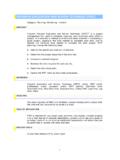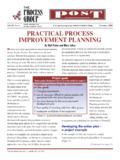Transcription of PARETO ANALYSIS - Improhealth
1 1 PARETO ANALYSIS Category: ANALYSIS Tools AB ST RAC T PARETO ANALYSIS (G) is a statistical technique in decision making that is used for the selection of a limited number of tasks that produce significant overall effect. It uses the PARETO Principle (also know as the 80/20 rule) the idea that by doing 20% of the work you can generate 80% of the benefit of doing the whole job. Or in terms of quality improvement, a large majority of problems (80%) are produced by a few key causes (20%) KEYWORDS PARETO ANALYSIS , PARETO Paradigm, PARETO Chart(G), PARETO Principle, Quality Control, organizing data, frequency of impact of problems, process improvement OB JEC T I VES A PARETO chart has the following objectives: Separate the few major problems from the many possible problems so you can focus your improvement efforts.
2 Arrange data according to priority or importance. Determine which problems are most important using data, not perceptions. FI ELD OF APPLI C AT I ON PARETO diagrams could be applied in: designing of medical processes in order to identify errors, faults, incidents or in the construction of a system that reduces the risk of medical care. analyzing performance data in health organizations. RELAT ED T OOLS Fishbone diagram, Scatter Diagram, Run Charts, Flow Charts DESC RI PT I ON The PARETO diagram is named after Vilfredo PARETO , a 19th-century Italian economist who conducted a study in Europe in the early 1900s on wealth and poverty.
3 He found that wealth was concentrated in the hands of the few and poverty in the hands of the many. The principle is based on the unequal distribution of things in the universe. It is the law of the "significant few 2 versus the trivial many." The PARETO Principle is a rule-of-thumb, which states that: 20 percent of the problems have 80 percent of the impact. The 20 percent of the problems are the vital few and the remaining problems are the trivial many. From the quality point of view, this diagram was introduced by the professor J.
4 M. Juran, as an instrument for the classification of the problems of quality: Major problems, they are only a few, but their results are quite important; Secondary problems, there are also a great deal of minor problems, but their results are limited. A PARETO Diagram is a good tool to use when the process investigated produces data that are broken down into categories and you can count the number of times each category occurs. A PARETO diagram puts data in a hierarchical order, which allows the most significant problems to be corrected first.
5 The PARETO ANALYSIS technique is used primarily to identify and evaluate nonconformities, although it can summarize all types of data. It is the perhaps the diagram most often used in management presentations. Typical observations from PARETO diagram analyses might reveal: 80% of all warranty repairs of a product were attributed to 20% of its parts. 75% of quality defects (G) result from 15% of operations within a process. 10% of the items inventoried represent 70% of the total cost of inventory. HOW T O USE I T : PARETO Diagram helps teams focus on the small number of really important problems or causes of problems.
6 This tool is useful in establishing priorities by showing which are the most critical problems to be tackled or causes to be addressed. Comparing PARETO diagram of a given situation over time can also determine whether an implemented solution reduced the relative frequency or cost of that problem or cause If one is trying to take action based upon causes of accidents or events, it is generally most helpful to focus efforts on the most frequent causes. Going after an "easy" yet infrequent cause will probably not reap benefits. HOW T O C ON ST RUC T The chart is similar to the histogram or bar chart, except that the bars are arranged in decreasing order from left to right along the abscissa.
7 Each bar represents only a category of faults, arranged in a decreasing way, from left to the right, according to their importance. The steps necessary to construct a PARETO diagram are: 3 Step 1 - Record the raw data. List each category and its associated data count. Step 2 - Order the data. Prepare an ANALYSIS sheet, putting the categories in order and placing the one with the largest count first. Step 3 - Label the left-hand vertical axis. Make sure the labels are spaced in equal intervals from 0 to a round number equal to or just larger than the total of all counts.
8 Provide a caption to describe the unit of measurement being used. Step 4 - Label the horizontal axis. Make the widths of all of the bars the same and label the categories from largest to smallest. An "other" category can be used last to capture several smaller sets of data. Provide a caption to describe them. If the contributor names are long, label the axis A, B, C, etc. and provide a key. Step 5 - Plot a bar for each category. The height of each bar should equal the count for that category. The widths of the bars should be identical. Step 6 - Find the cumulative counts.
9 Each category's cumulative count is the count for that category added to the counts for all larger categories. Step 7 - Add a cumulative line. This is optional. Label the right axis from 0 to 100%, and line up the 100% with the grand total on the left axis. For each category, put a dot as high as the cumulative total and in line with the right edge of that category's bar. Connect all the dots with straight lines. The major advantage of PARETO Diagram is the fact that is easier to see on such a diagram the most important faults, and the main disadvantage is the hierarchical system of the faults, of non-conformities that frequently depend on the person that makes it.
10 B EN EFI T S PARETO diagrams: Solves efficiently a problem by the identification and the hierarchisation, according to their importance, of the main causes of the faults. Sets the priorities for many practical applications. Some examples are: process improvement efforts for increased unit readiness, customer needs, suppliers, investment opportunities. Shows where to focus efforts. Allows better use of limited resources. PREREQUI SI T ES Trained personnel. Efforts focused on the most frequent causes. 4 ANALYSIS performed over a fixed time interval of performance indicator results.









